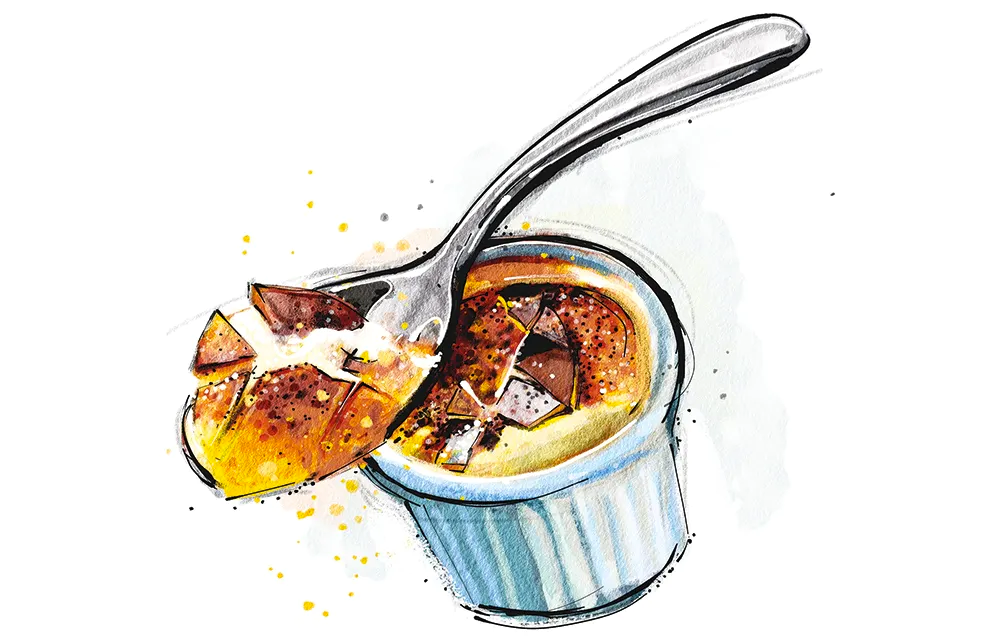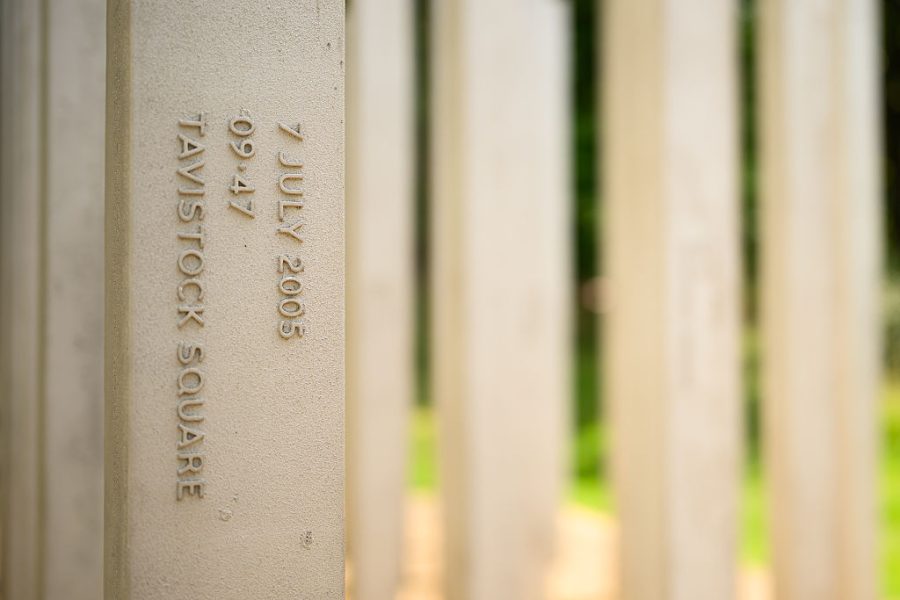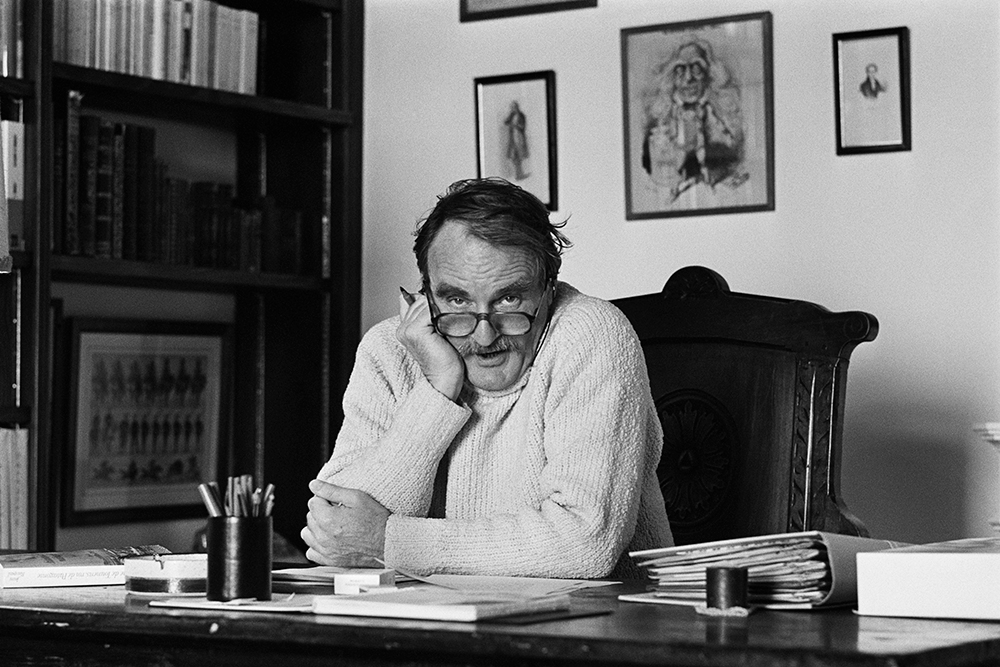If a rose by any other name would smell as sweet, then a Trinity or Cambridge burnt cream must taste as sweet as its French twin, the crème brûlée. The two cooked custard dishes are essentially identical: an egg yolk-rich baked custard served cold and topped with a layer of hard caramel.
Both are similar to the crema Catalana you find throughout Spain (known as “crema cremada” in Catalan cuisine), but Catalana is made with milk rather than cream. It means it is lighter, and tends to have a thinner, paler caramel layer. Lemon or orange zest and a cinnamon stick are often used as flavoring for the Spanish pudding, whereas a burnt cream or crème brûlée is traditionally only flavored with vanilla.
The British version comes from Trinity College, Cambridge. Rabble-rousers would have you believe that there’s a debate as to which came first, the Cambridge burnt cream or the crème brûlée, but that’s not really true. The custard was first written about in French cookbooks and referred to as crème brûlée in 1691, although accounts suggest that the dish had been around for at least sixty years in England before the French got to it.
By 1879, it was being served regularly at Trinity, with the college crest branded into the caramelized top. Florence White, writing in Good Things in England, tells the story of an undergraduate there offering up the recipe — which she was told came from a country house in Aberdeenshire — only for the college kitchens to roundly reject it… until he became a fellow thirty years later, when suddenly his word had more sway, and it became the college’s signature dish.
The college itself lays no claim to the invention of the original burnt cream, stating baldly that “the story that crème brûlée itself was invented at the college almost certainly has no basis in fact.” In a world where the origins of recipes and puddings are claimed and disputed, I rather like that culinary shrug of the shoulders: yes, Trinity have their own version, but they’re not going to suggest they got there before the French.
Whatever you call it, and wherever you eat it, the satisfaction of smacking the top of a burnt cream with the back of a spoon is even greater than that of breaking into a boiled egg or smashing a poppadom. It is the caramelized top that sets the dish apart from other baked custards: the smoky, bittersweet caramel acting as a counterpoint to the mellow, rich custard beneath.
I rather feel that a bad créme brûlée is better than no crème brûlée at all, but a good one is fantastic, and there are ways to ensure that yours is exemplary. First, a deep ramekin rather than a gratin dish makes for a better custard and gives a greater custard to caramel ratio. Secondly, using a bain marie further protects the delicate custard, cooking it gently. It’s possible to make a burnt cream without cooking the custard over the hob to thicken it first, but cooking it slowly is the old school way of making it and, more importantly, ensures the smoothest, most luscious custard with only the slightest wibble.
And finally that all-important caramel lid: the key is to take your time. It helps to use a cook’s blowtorch, and slowly but methodically melt the sugar, letting it sizzle and relax into a pool of liquid which will harden into a perfect glassy layer. By the time you’re finished, the caramel should be mahogany with just a few leopard spots of black. You should be able to tap a fingernail against it and feel a thin but definite sheet across the surface of the custard, just crying out to be cracked.
Makes 4 puddings
Takes 15 mins
Bakes 40 mins
- 20 fl oz double cream
- 1 vanilla pod
- 5 egg yolks
- 1¾ oz superfine sugar
- 4 tbsp superfine sugar
- Preheat the oven to 250°F and place four 6 fl oz ramekins in a roasting tin
- Pour the cream into a medium-sized saucepan and place on a medium heat. Cut the vanilla pod in half lengthways and scrape out the seeds with the back of your knife. Put these seeds and the scraped vanilla pod into the cream, and heat it until steaming
- Meanwhile, whisk the egg yolks and caster sugar together in a mixing bowl until the mixture is noticeably paler than when you began
- Once the cream is steaming, remove the vanilla pod and discard it. Pour a stream of the hot cream on to the egg yolk mix, whisking all the while to combine. Now pour that mixture back into the saucepan and, using a spatula, stir continually over a low heat until the custard thickens. You’ll know it’s ready when, if you dip a spoon into the pan and then draw a line through the custard with your finger, the line remains
- Once the custard has thickened, pour it through a sieve into the four ramekins: they should be quite full. Boil the kettle and fill the roasting tin with hot water until it comes about halfway up the ramekins. Carefully transfer the tin to the oven, and bake for forty minutes
- Once baked, remove the ramekins from their roasting tin and, when they have cooled, refrigerate them
- Just before serving, sprinkle a tablespoon of caster sugar on top of each pudding. Slowly and steadily direct a cook’s blowtorch across the sugar until it melts and forms a sheet of caramel. You can use the grill here if you don’t have a blowtorch, but be eagle-eyed to prevent your burnt cream from becoming literally burnt. Leave for a moment for the caramel to cool and harden, then serve
This article was originally published in The Spectator’s UK magazine. Subscribe to the World edition here.

























